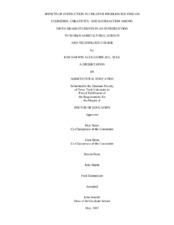| dc.description.abstract | The use of Creative Problem Solving (CPS) as an instructional strategy to increase the creativity levels of students across all levels of the curriculum is currently a popular topic of investigation. Curriculum content and the underlying objectives that are presented to students in public schools have been the subject of close scrutiny since school accountability became a hot topic during the 1980's. However, despite all the efforts to improve student productivity through a well defined curriculum, and possibly because of the increased emphasis on student accountability to reflect that student improvement, concern for the apparent declining creativity levels among students appears to be growing.
The purpose of this dissertation was to compare conventional instructional methodologies with those of creative problem solving. It was hypothesized that students' low, high, and total cognition levels, overall creativity levels, and satisfaction with instructional methodologies, improve as a result of instruction through creative problem solving strategies. By improving the levels of creativity within students, they will be better equipped to deal with the complex types of problems the future will present.
This study utilized an experimental, posttest only, control group design. Participants were ninth grade students (n=20) who were enrolled in an Introduction to World Agricultural and Science Technology I course. Posttests were administered to measure low, high, and total levels cognition at the conclusion of the course. For this measure of the dependent variable, a forty question (10 true/false, 25 multiple choice, and 5 short answer) test was administered. Pretests and posttests were administered to measure student creativity. A standardized Torrance Test of Creative Thinking (TTCT) was used as the measure of the dependent variable of creativity. Pretests, mid-tests, and posttests were used to measure student satisfaction. A satisfaction instrument developed by Brashears (2004) was used for the measurement of clarity, delivery, content, and total satisfaction as the dependent measure of satisfaction. These instruments were used to measure the five research hypotheses of the study.
Results of the study did not support the hypotheses that significant differences exist between creative problem solving and traditional instructional strategies, as they pertain to student cognition, creativity, and satisfaction. However, although not significant, possibly due to the small sample size, upon closer examination of group means, one can detect definite patterns of greater mean score gains among the CPS group over the traditional group in cognition, creativity, and satisfaction. Based on these findings, this researcher suggests that replications of this study be performed with larger sample sizes in different curriculum areas to further perpetuate the integration of creative problem solving strategies as an effective instructional strategy for all age groups and in all areas of the curriculum. | en |


